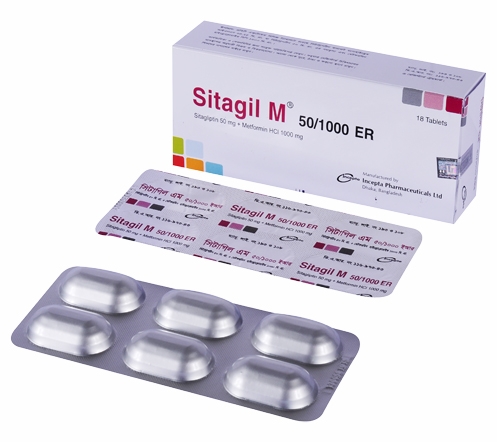ঔষধের বিস্তারিত বা বিকল্প ঔষধ জানতে ঔষধের নাম দিয়ে সার্চ দিন। যেমন- Napa বা Alatrol বা Amodis
Sitagil M 50mg+1000mg
TabletSitagliptin + Metformin Hydrochloride
Incepta Pharmaceuticals Ltd
Other Strength:
- Sitagil 50mg
Alternative:
- Sitomet 50mg+1000mg
- Siglimet 50mg+1000mg
- Siglimet XR 50mg+1000mg
- Janmet 50mg+1000mg

Sitagil M
Presentation
Sitagil M 50/500 ER: Each extended release tablet contains Sitagliptin Phosphate Monohydrate INN 64.25 mg eq. to Sitagliptin 50mg & Metformin HCl BP 500 mg.
Sitagil M 50/1000 ER: Each extended release tablet contains Sitagliptin Phosphate Monohydrate INN 64.25 mg eq. to Sitagliptin 50 mg & Metformin HCl BP 1000 mg.
Description
Sitagliptin is a dipeptidyl peptidase-4 (DPP-4) inhibitor, which exerts its action by slowing the inactivation of incretin hormones. Incretin hormones, including glucagon-like peptide-1(GLP-1) and glucose-dependent insulinotropic polypeptide (GIP), are released by the intestine throughout the day and levels are increased in response to a meal. These hormones are rapidly inactivated by the enzyme, DPP-4. The incretins are part of an endogenous system involved in the physiologic regulation of glucose homeostasis. When blood glucose concentrations are normal or elevated, GLP-1 and GIP increase insulin synthesis and release from pancreatic beta cells by intracellular signaling pathways involving cyclic AMP. GLP-1 also lowers glucagon secretion from pancreatic alpha cells, leading to reduced hepatic glucose production. The pharmacologic mechanism of action of Metformin is different from other classes of oral antihyperglycemic agents. Metformin decreases hepatic glucose production, decreases intestinal absorption of glucose, and increases peripheral glucose uptake and utilization.
Indications
Sitagliptin + Metformin ER is a dipeptidyl peptidase-4 (DPP-4) inhibitor and biguanide combination product indicated as an adjunct to diet and exercise to improve glycemic control in adults with type 2 diabetes mellitus when treatment with both Sitagliptin and Metformin extended release is appropriate.
Dosage & Administration
May adjust the dosing based on effectiveness and tolerability while not exceeding the maximum recommended daily dose of 100 mg Sitagliptin and 2000 mg Metformin extended release.
Administer once daily with a meal preferably in the evening. Gradually escalate the dose to reduce the gastrointestinal side effects due to Metformin. Maintain the same total daily dose of Sitagliptin and Metformin when changing between Sitagliptin + Metformin ER, without exceeding the maximum recommended daily dose of 2000 mg Metformin extended release.
Swallow whole. Never split, crush or chew.
Side Effects
• The most common adverse reactions reported in ≥5% of patients simultaneously started on Sitagliptin and Metformin and more commonly than in patients treated with placebo were diarrhea, upper respiratory tract infection, and headache.
• Adverse reactions reported in ≥5% of patients treated with Sitagliptin in combination with Sulfonylurea and Metformin and more commonly than in patients treated with placebo in combination with Sulfonylurea and Metformin were hypoglycemia and headache.
• Hypoglycemia was the only adverse reaction reported in ≥5% of patients treated with Sitagliptin in combination with insulin and Metformin and more commonly than in patients treated with placebo in combination with insulin and Metformin.
Precautions
Do not use the combination of Sitagliptin & Metformin in patients with hepatic disease. Before initiating the combination and at least annually thereafter, assess renal function and verify as normal. May need to discontinue the combination and temporarily use insulin during periods of stress and decreased intake of fluids and food as may occur with fever, trauma, infection or surgery.
Use in Pregnancy & Lactation
• There are no adequate and well-controlled studies in pregnant women with Sitagliptin + Metformin ER or its individual components; therefore, the safety of Sitagliptin + Metformin ER in pregnant women is not known. Sitagliptin + Metformin ER should be used during pregnancy only if clearly needed.
• It is not known whether Sitagliptin or Metformin are excreted in human milk. Because many drugs are excreted in human milk, caution should be exercised when Sitagliptin + Metformin ER is administered to a nursing woman.
Drug Interaction
Carbonic anhydrase inhibitors should be used with caution treated with Sitagliptin + Metformin ER, as the risk of lactic acidosis may increase.
Careful patient monitoring and dose adjustment of Sitagliptin + Metformin ER and/or the interfering drug is recommended in patients who are taking cationic medications that are excreted via the proximal renal tubular secretory system.
Over Dose
Sitagliptin
There is no experience with doses above 800 mg in clinical studies. In the event of an overdose, it is reasonable to employ the usual supportive measures, e.g., remove unabsorbed material from the gastrointestinal tract, employ clinical monitoring (including obtaining an electrocardiogram), and institute supportive therapy as indicated by the patient\'s clinical status.
Prolonged hemodialysis may be considered if clinically appropriate. It is not known if Sitagliptin is dialyzable by peritoneal dialysis.
Metformin Hydrochloride
Overdose of Metformin Hydrochloride has occurred, including ingestion of amounts greater than 50 grams. Hypoglycemia was reported in approximately 10% of cases, but no causal association with Metformin Hydrochloride has been established. Lactic acidosis has been reported in approximately 32% of Metformin overdose cases. Hemodialysis may be useful for removal of accumulated drug from patients in whom Metformin overdose is suspected.
Commercial Pack
Sitagil M 50/500 ER: Each box contains 5 blister strips of 4 tablets.
Sitagil M 50/1000 ER: Each box contains 3 blister strips of 6 tablets.
এই পাতাটি ২২৪ বার দেখা হয়েছে
রাজডক কী?
ফ্রী সদস্য হোন Click Here
ডাক্তার হিসাবে যোগদান করতে Click Here
নার্স / টেকনোলজিস্ট হিসাবে যোগদান করতে Click Here
ফ্রী সদস্য হোন Click Here
ডাক্তার হিসাবে যোগদান করতে Click Here
নার্স / টেকনোলজিস্ট হিসাবে যোগদান করতে Click Here

